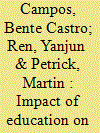| Srl | Item |
| 1 |
ID:
149773


|
|
|
|
|
| Summary/Abstract |
This article analyzes the impact of education on income inequality between ethnic minorities and Han in China by using the data from the China Health and Nutrition Survey (CHNS) over the period 1993–2011. An instrumental variable approach using two institutional changes is applied to address the endogeneity of education in income equations for various subsamples. To investigate the impact of education on income inequality between ethnic minorities and Han, we introduce an interaction term between the ethnic minority status and years of education. Our results suggest that there exists significant income inequality to the disadvantage of ethnic minorities for the full, female, and urban samples, and depending on the instrument also for the rural sample. Nevertheless, our results for these samples show specific returns to education for ethnic minorities, which implies that a portion of the income gap can be overcome with additional education. We find that in general one additional year of education will increase earned incomes of ethnic minorities by 26.3–28% and in particular by 13.5–14.4% for women from an ethnic minority group, by 10.4–14% for ethnic minorities with urban household registration, and by 10.8% for ethnic minorities with rural household registration. However, we cannot obtain conclusive results for the male sample due to weak instruments.
|
|
|
|
|
|
|
|
|
|
|
|
|
|
|
|
| 2 |
ID:
156102


|
|
|
|
|
| Summary/Abstract |
What would a ‘good’ industrial policy in the realm of cotton production look like? This article seeks to address this question through a focus on reforms to the cotton sector in Kazakhstan. In contrast with neighbouring Uzbekistan and Turkmenistan, administrators in Kazakhstan had widely freed the cotton sector from government control as early as 1998. Agricultural collectives had been replaced by small private farms, and commercial cotton processors and traders entered the sector. However, in 2007, regulation tightened again and forced ginneries to use a complex warehouse receipt system without making sure that it was accepted by stakeholders and without appropriate institutions for implementing it in place. Moreover, it imposed financing restrictions on ginneries, which were major loan and input providers to farmers. In the following years, private producers and investors turned away from cotton, and cotton area and output fell substantially. We position our analysis in the broader debate about the right approach to industrial policy and argue that the cotton sector performance after 2007 shows how ill-designed regulation and government interference can turn a promising economic sector towards decline.
|
|
|
|
|
|
|
|
|
|
|
|
|
|
|
|